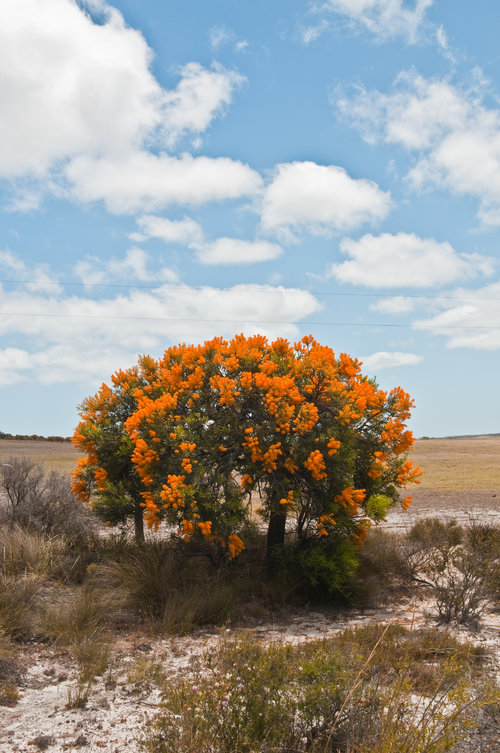#santalales

When we think of mistletoes, we generally think about those epiphytic parasites living on branches way up in the canopy. The mistletoe we are discussing in this post, however, is a decent sized tree. Nuytsia floribunda is a native of western Australia where it is known locally as moojar or the Christmas tree. To the best of our knowledge, it is the largest mistletoe known to science.
Nuytsia floribunda is a member of the so-called showy mistletoe family (Loranthaceae). It along with all of its mistletoe cousins reside in the order Santalales but from a phylogenetic standpoint, the family Loranthaceae is considered sister to all other mistletoes. This has excited my botanists as it allows us a chance to better understand how parasitism may have evolved in this group as a whole.

Speaking of parasitism, there are some incredible things going on with N. floribunda that are worth talking about. For starters, it is not fully parasitic but rather hemiparasitic. As you can tell by looking at the tree decked out in a full canopy of leaves, N. floribunda is entirely capable of photosynthesizing on its own. In fact, experts feel that it is fully capable of meeting all of its own carbohydrate needs. Instead, it parasitizes other plants in order to acquire water and minerals. How it manages this is remarkable to say the least.
Nuytsia floribunda is a root parasite. Its own roots fan out into the surrounding soil looking for other roots to parasitize. Amazingly, exploratory roots of individual N. floribunda have been found upwards of 110 meters (360 ft.) or more away from the tree. When N. floribunda do find a suitable host root, something incredible happens. It begins to form specialized roots called “haustoria”, which to form a collar-like structure around the host’s roots.

The collar gradually swells and a small horn forms on the inside of the haustoria. Swelling of the haustoria is the result of an influx of water and as the pressure around the host root builds, the haustorial horn of N. floribunda physically cuts into its victim. Once this cut is formed, the haustoria form balloon-like outgrowths which intrude into the xylem tissues of the host root, thus forming the connection that allows N. floribunda to start stealing the water and minerals it needs.
Even more amazing is the fact that roots aren’t the only thing that N. floribunda will attempt to exploit. Many inanimate objects have been found wrapped up in a haustorial embrace including dead twigs, rocks, fertilizer granuals, and even electric cables! Its non-selective parasitic nature appears to have left it open to exploring other, albeit dead end options. I don’t want to paint the picture that this tree as the enemy of surrounding vegetation. It is worth noting that N. floribunda extracts very little from any given host so its impact is spread out among the surrounding vegetation, making its overall impact on host plants minimal most of the time.

Provided its needs have been met, N. floribunda puts on one heck of a show around December. In fact, the timing of its blooms is the reason it earned the common name of Christmas tree. Flowering for this species is not a modest affair. Each tree is capable of producing multiple meter-long inflorescences decked out in sprays of bright orange to yellow flowers. The flowers themselves produce copious amounts of pollen and nectar, making it an important food source for resident pollinators. Though many different species have been documented visiting the flowers, it is thought that beetles and wasps are the most effective at pollination.
Seed dispersal for N. floribunda is mainly via wind. Each fruit is adorned with three prominent wings. After they detach from the tree, the fruits usually break apart into three samaras, each with its own wing. The key for success of any propagule is ending up in a site suitable for germination. According to some, this can be a bit tricky and attempts at cultivating this plant in captivity have not been terribly successful. It would seem that nature knows best when it comes to reproductive success in N. floribunda. It may be worth trying to figure it out though because recent evidence suggests that this species is not faring well with human development. As the surrounding landscapes of western Australia become more and more urbanized, plants like N. floribunda seem to be on the decline. Perhaps renewed interest in growing this species could change the tide for it as well as others.


